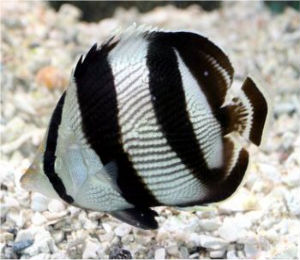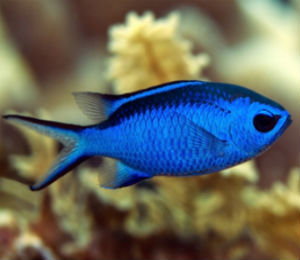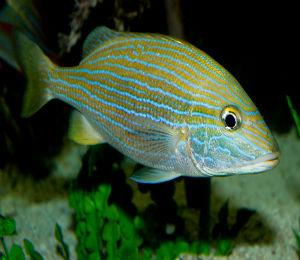Our catamaran took us seven miles off Key West’s coast to the Florida Keys Reef. The coral reef that surrounds Key West stretches from the southern tip of Florida all the way to Dry Tortugas, it covers a distance of approximately 170 miles. At its widest point, the Florida Reef is four miles wide. It is the third largest reef system in the world.
For a few cadets it was the first time snorkeling but the shallow Caribbean waters perfect for easy first time snorkelers. The crew answers all our questions showed us how to use all the equipment. We had a sanitized snorkel, mask, fins and buoyancy vest and In no time at all, we were immersed in the colorful world under the calm water. We saw so many species of fish, coral and marine wildlife, these colorful organisms live here on the only coral barrier reef in North America.
See more species here.
This reef flourishes in Key West because the water is shallow and warm, which is the ideal environment for polyps. This also allows snorkelers to get up close and personal with the sea life living in the shelter of the reef and to appreciate the varieties of coral that comprise the reefs. Unfortunately, with the reefs so close, it is easy for snorkelers to damage the reef without even realizing it. We were asked to please not touch the coral on purpose. The lightest touch can unintentionally destroy the miniature polyps and damage the coral. And to be aware of where our fins were at all times because your fins may accidentally brush the coral that is now underneath your feet and damage it.
When we returned to the catamaran where we treated to lunch, and then lounged on the deck of the catamaran until we got back to the dock.
The coral reef system in Key West forms a complex ecosystem filled with tremendous biodiversity. Among the myriad of inhabitants, you will be astonished by the numerous and diverse species of reef fish that utilize the structures of the coral formations as shelter. The sheer number of fish that surround the only living coral reef in North America is certainly of mention - you will be overwhelmed by the schools of vibrant fish that shimmer as they speed through the underwater world in unison. Hundreds of species of fish coexist, even in only a small region of this living reef.
The Key West coral reef is a complex eco-system and one of the most diverse in world. It is the equivalent of the of the tropical rain forests on land, and is the home to more than a fourth of all known fish species. Coral reefs have been around for approximately 200 million years, and some scientist even believe up to 400 million years ago they existed. The coral reefs take time to grow and it is believed they reached their level of biological diversity about 50 million years ago.
Coral reef is made up of thin layers of calcium carbonate that has been secreted over thousands of years by tiny soft-bodied animals by the billions called coral polyps. These polyps differ in sizes and can be as small as a pinhead to a foot in length, and each one lives in a symbiotic relationship with an algae. This algae, called Zooxanthellae, gives the coral its beautiful hue by taking in Carbon Dioxide, then giving off Oxygen. These millions of polyps start to form on the limestone that exist, and then create what we now know as a coral reef. In this coral reef system alone, you can find approximately 110 species of hard and soft coral and over 500 species of tropical reef fish.
This ecosystem is extremely precious to the waters of Key West, and deserves our care and respect. The coral reef of Key West has been under threat due to recent oil spills, and it's our duty to keep our mother Earth healthy and clean.
The coral reef system in Key West forms a complex ecosystem filled with tremendous biodiversity. Among the myriad of inhabitants, you will be astonished by the numerous and diverse species of reef fish that utilize the structures of the coral formations as shelter. The sheer number of fish that surround the only living coral reef in North America is certainly of mention - you will be overwhelmed by the schools of vibrant fish that shimmer as they speed through the underwater world in unison. Hundreds of species of fish coexist, even in only a small region of this living reef.
The Key West coral reef is a complex eco-system and one of the most diverse in world. It is the equivalent of the of the tropical rain forests on land, and is the home to more than a fourth of all known fish species. Coral reefs have been around for approximately 200 million years, and some scientist even believe up to 400 million years ago they existed. The coral reefs take time to grow and it is believed they reached their level of biological diversity about 50 million years ago.
Coral reef is made up of thin layers of calcium carbonate that has been secreted over thousands of years by tiny soft-bodied animals by the billions called coral polyps. These polyps differ in sizes and can be as small as a pinhead to a foot in length, and each one lives in a symbiotic relationship with an algae. This algae, called Zooxanthellae, gives the coral its beautiful hue by taking in Carbon Dioxide, then giving off Oxygen. These millions of polyps start to form on the limestone that exist, and then create what we now know as a coral reef. In this coral reef system alone, you can find approximately 110 species of hard and soft coral and over 500 species of tropical reef fish.




No comments:
Post a Comment